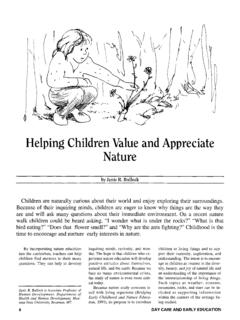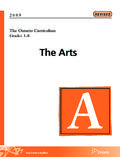Transcription of The Impact of After-School Programs That Promote ... - ed
1 The Impactof After-School ProgramsThat Promote Personaland social SkillsThe Impactof After-School ProgramsThat Promote Personaland social SkillsThe Impactof After-School ProgramsThat Promote Personaland social SkillsJoseph A. DurlakLoyola University ChicagoRoger P. WeissbergUniversity of Illinois ChicagoCollaborative for Academic, social , andEmotional Learning (CASEL)2007 This report is based on a grant awarded to theauthors by the William T. Grant have many people to thank. First, we want to acknowledge the financial support of the William T. GrantFoundation through grant #2212. The Foundation supported our review of Positive Youth DevelopmentPrograms, of which this review of After-School Programs is a part. Second, special thanks go to Robert , president of the Grant Foundation, for his continued encouragement of our work, and for inviting usto attend grantee meetings in Washington, , where we had the opportunity to meet other researchers, prac-titioners and policy advocates working in the After-School arena.
2 These contacts helped us realize the broadercontext of our project. We also wish to express our appreciation to David DuBois and Mark Lipsey, who provided us with helpfulcomments on an earlier draft of this report. We wish to thank David Wilson for providing the macros used tocalculate effects from each relevant outcome, and Mark Lipsey (again) for supplying the SPSS macros used toconduct the statistical analyses. An extremely valuable source of studies was the periodically up-dated out-of- school time database maintained by the Harvard Family Research Project We wish to thank Heather Weiss and theHFRP staff, especially Chris Wimer, for supplying copies of relevant reports that we were unable to obtain. Wealso appreciate the assistance of Nicole Yohalem and Karen Pittman from the Forum for Youth Investment fortheir help in disseminating our findings. Mary Utne O Brien and Kay Ragozzino deserve credit for preparing and posting this report on the CASELweb have been many undergraduate and graduate students associated with our larger project over theyears.
3 We express our gratitude to all of them, but extend special thanks to several students who were instru-mental in the final phases of this After-School review by re-checking the data set, redoing statistical analyses,doing additional coding and helping in the final preparation of this report. In alphabetical order, these individu-als are Sasha Berger, Christine Celio, Molly Pachan and Kriston citation: Durlak, J. A., & Weissberg, R. P. (2007). The Impact of After-School Programs that promotepersonal and social skills . Chicago, IL: Collaborative for Academic, social , and Emotional document may be retrieved from questions about this study or related work may be addressed to:Joseph A. Durlak, P. Weissberg, of PsychologyCollaborative for Academic, social , andLoyola University ChicagoEmotional Learning (CASEL)6525 N. Sheridan RoadDepartment of Psychology (MC 285)Chicago, Il 60626 University of Illinois at ChicagoEmail: West Harrison StreetChicago, IL 60607-7137 Email: for Academic, social , and Emotional Learning20072 Table of ContentsAcknowledgements.
4 2 Table of Contents .. 3 List of Tables.. 3 Executive Summary .. 5 Abstract.. 9 Introduction .. 10 Method .. 12 Results.. 17 Discussion .. 22 Appendix A: Bibliography of Reviewed Studies .. 32 Appendix B: Information on Reviewed Studies.. 35 Appendix C: Measures and Effect Sizes for Each Outcome Category and Study .. 40 References .. 48 List of TablesTable 1 Descriptive Characteristics of Reviewed Studies .. 17 Table 2 Stem and Leaf Distribution of Winsorized Study-Level Effect Sizes .. 18 Table 3 Mean Effects for Different Outcomes in Participating Youth .. 18 Table 4 Outcomes for Programs that Did or Did Not Meet Criteria Regarding the Use of Evidence-basedTraining Procedures .. 19 Table 5 Summary of Significant Predictors of Effect Size for Different Outcomes .. 21 Table 6 Mean Effects at Follow-Up for Different Outcomes .. 21 Table 7 Comparing the Mean Effects from Effective After-School Programs to the Results of Other UniversalInterventions for children and Adolescents.
5 23 Table 8 An Illustration of the Value-Added Benefits of Effective After-School Programs .. 28 Table B1 Descriptive Information on Reviewed Reports with Effect Sizes At Post .. 35 Table B2 Descriptive Information on Reviewed Reports with Follow-Up Effect Sizes.. 37 The Impact of After-School Programs that Promote personal and social Skills3 Collaborative for Academic, social , and Emotional Learning20074 Executive SummaryEvidence is mounting that where and how youth spend their time outsideof normal school hours has important implications for their develop-ment. On the negative side, estimates suggest that more than 7 millionchildren in the United States are without adult supervision for some period oftime after school . This unsupervised time puts youth at risk for such negativeoutcomes as academic and behavioral problems, drug use and other types ofrisky behavior (Weisman & Gottfredson, 2001). On the positive side, youngpeople benefit when they spend time engaged in structured pursuits that offeropportunities for positive interactions with adults and peers, encourage themto contribute and take initiative, and contain challenging and engaging tasksthat help them develop and apply new skills and personal talents (AmericanYouth Policy Forum, 2006; Carnegie Corporation, 1992; Larson & Verma, 1999;National Research Council & Institute of Medicine, 2002).
6 As a result, there has been increasing interest in After-School Programs (ASPs) that can provide youth with a safe and supportive adult-supervisedenvironment and offer them various growth-enhancing opportunities, includingactivities and experiences that Promote academic, personal , social and recre-ational development. There is strong public support for After-School Programs ,particularly from working parents who cannot be with their children immedi-ately after school . Funding from state, private and federal sources has support-ed existing ASPs and created new offerings in many communities. The federalgovernment invested $ billion in After-School Programs in 2002( ).What is known about the Impact of After-School Programs ? Previous reviewshave concentrated on the academic benefits of Programs that offer tutoring orother forms of academic assistance to youth, and the results have been review of 35 studies reported that the test scores of low-income, at-riskyouth improved significantly in both reading and mathematics after they par-ticipated in After-School Programs (Lauer et al.)
7 , 2006). Academic outcomes forother youth, however, have been inconsistent (Kane, 2003; Scott-Little,Hamann & Jurs, 2002; Vandell et al., 2004; Zief, Lauver & Maynard, 2004). Asa result, authors have stressed the need for careful evaluations of the effective-ness of different Programs and the factors associated with positive outcomes,along with realistic expectations about the academic gains that can be achieved(Bodilly & Beckett, 2005; Granger & Kane, 2004; Vandell et al., 2004, 2005).However, the personal and social benefits of After-School Programs have beensomewhat overlooked, at least in terms of formal evaluation. Many acknowl-edge that After-School Programs can improve young people s personal and socialdevelopment, and findings from some individual studies have been positive( , Harvard Family Research Project, 2003). But no review has been done toevaluate systematically the Impact of After-School Programs that attempt toenhance youths personal and social skills , identify the nature and magnitudeof the outcomes of such Programs , and describe the features that characterizeThe Impact of After-School Programs that Promote personal and social Skills5 Estimates suggestthat more than 7million children inthe United States arewithout adultsupervision for someperiod of time Programs .
8 These are the goals of the current the Programs in the current review were selected because their overallmission included promoting young people s personal and social Programs offer a mix of activities, but the current review concentrates onthose aspects of each program that are devoted to developing youths personaland social is extensive evidence from a wide range of promotion, prevention andtreatment interventions that youth can be taught personal and social skills (Collaborative for Academic, social , and Emotional Learning, 2003;Commission on Positive Youth Development, 2005; L Abate & Milan, 1985;Greenberg et al., 2003). Moreover, theory and research about skills training ofchildren and adolescents indicate that learning is more likely to occur when evi-dence-based training approaches are used (Collaborative for Academic, social ,and Emotional Learning, 2003; Durlak, 1997, 2003; Elias et al.)
9 , 1997; NationalResearch Council & Institute of Medicine, 2002; Payton et al. 2000; Weissberg &Greenberg, 1998). Effective approaches to skills development are sequential,active, focused and explicit. Knowing this, we hypothesized that Programs thatused all four approaches to Promote youths personal and social skills would bemore successful than those that did not, and we developed a method to capturethe application of these evidence-based approaches. (The rationale and codingmethodology for these variables are described in the full report.)We expected that youth would benefit in multiple ways from effective pro-gramming, so we examined outcomes in three general areas: feelings and atti-tudes, indicators of behavioral adjustment, and school performance. Our objec-tive was to answer two research questions:1. What types of outcomes can we expect from After-School Programs thatattempt to foster young people s personal and social skills ?
10 2. Can we identify program characteristics that are associated with betterresults?MethodWe only considered After-School Programs that attempted to Promote personaland social skills . The personal and social skills targeted in these programscould include one or more skills in such areas as problem-solving, conflict reso-lution, self-control, leadership, responsible decision-making, and enhancementof self-efficacy and self-esteem. We defined After-School Programs as interven-tions that were offered to children between the ages of 5 and 18, operated dur-ing at least part of the school year ( , September to June) and occurred out-side of normal school hours, which are typically 8 to 2:30 , Mondaythrough Friday. To be included, reports had to have a control group, presentsufficient information for analysis and appear by Dec. 31, careful and systematic search for published and unpublished studies net-ted a set of reports that provided information on 73 Programs .












